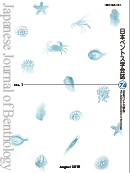Volume 74, Issue 1
Displaying 1-11 of 11 articles from this issue
- |<
- <
- 1
- >
- >|
Original Articles
-
2019Volume 74Issue 1 Pages 1-15
Published: August 31, 2019
Released on J-STAGE: September 09, 2019
Download PDF (2179K) -
2019Volume 74Issue 1 Pages 16-24
Published: August 31, 2019
Released on J-STAGE: September 09, 2019
Download PDF (1586K) -
2019Volume 74Issue 1 Pages 25-34
Published: August 31, 2019
Released on J-STAGE: September 09, 2019
Download PDF (1194K)
Note
-
2019Volume 74Issue 1 Pages 35-40
Published: August 31, 2019
Released on J-STAGE: September 09, 2019
Download PDF (900K)
-
2019Volume 74Issue 1 Pages 41-42
Published: August 31, 2019
Released on J-STAGE: September 09, 2019
Download PDF (263K) -
2019Volume 74Issue 1 Pages 43-63
Published: August 31, 2019
Released on J-STAGE: September 09, 2019
Download PDF (6175K) -
2019Volume 74Issue 1 Pages 64-74
Published: August 31, 2019
Released on J-STAGE: September 09, 2019
Download PDF (5692K) -
2019Volume 74Issue 1 Pages 75-80
Published: August 31, 2019
Released on J-STAGE: September 09, 2019
Download PDF (1227K)
Information and Announcement
-
2019Volume 74Issue 1 Pages 81
Published: August 31, 2019
Released on J-STAGE: September 09, 2019
Download PDF (179K)
Business Report
-
2019Volume 74Issue 1 Pages 82-84
Published: August 31, 2019
Released on J-STAGE: September 09, 2019
Download PDF (217K)
Information for contributors
-
2019Volume 74Issue 1 Pages 85-87
Published: August 31, 2019
Released on J-STAGE: September 09, 2019
Download PDF (182K)
- |<
- <
- 1
- >
- >|
